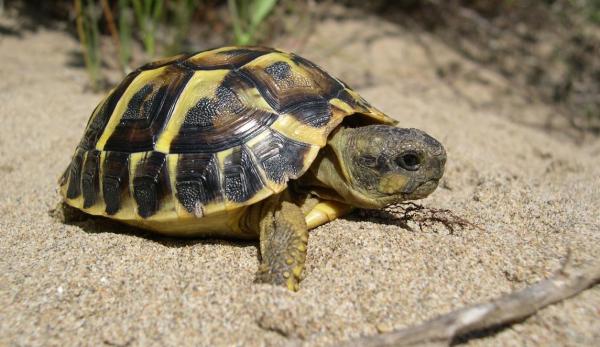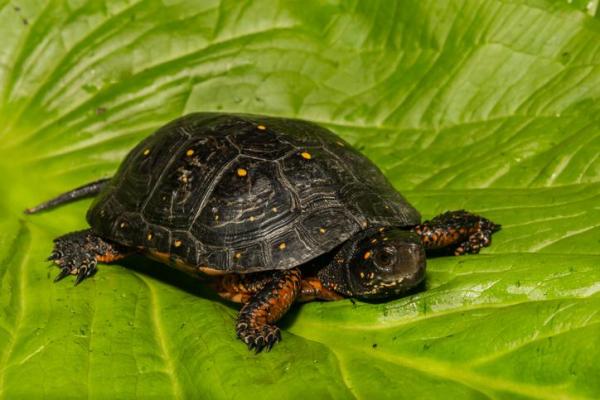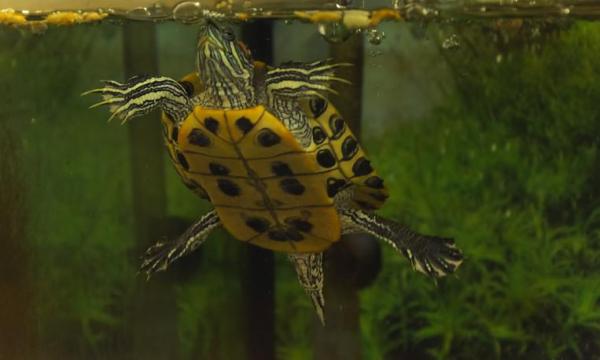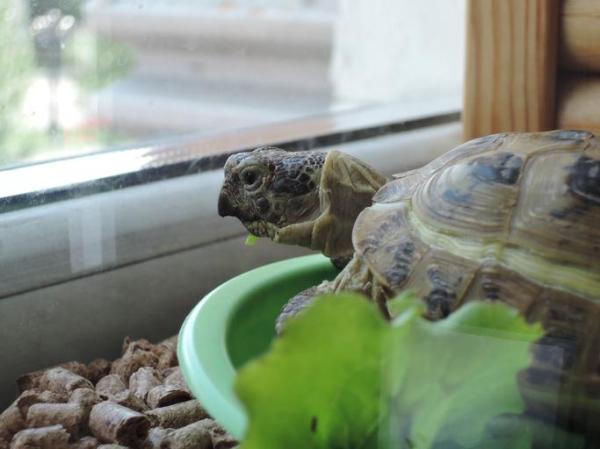
The appeal of turtles as pets rests with the individual. Some people prefer cats and dogs because they play with their guardians, are cuddly and are a larger part of pet culture. For others, the turtle has their own charm. They are adorable in their own way, their pace of life can help us to relax and they live longer than many other companion animals. One common belief is that it does not require much effort to care for turtles. This myth is a damaging one which has led to hurting the well-being of many turtles.
AnimalWised brings you everything you need to know about pet turtles in terms of care, food and anything else needed to ensure they have a happy life. We also look into whether having a pet turtle is a good idea in the first place.
Can you have turtles as pets?
Turtles are reptile which belong to the order Testudines. They have populated the earth since the Triassic period with little change in the past 200 million years or so. Among their most notable features are the fact they have a hard shell which protects them from predators. They are also long-lived. The common box turtle has an average lifespan of 50 years, but can live to over a century.
Difference between turtles and tortoises
There are some generalizations made about turtles and tortoises. As is almost always the case with animal taxonomy, things can get complicated. One simple way to think about the difference is that all tortoises are turtles, but not all turtles are tortoises.
A tortoise is a type of turtle which lives exclusively on land. Other turtles are at least partly aquatic, with some exceptions. Another generalization is that tortoises are generally herbivorous, while turtles tend to be omnivorous. The legs of turtles and tortoises are different, with many turtles bearing flippers to aid them in swimming. Terrapins are another type of turtle, specifically those which live in freshwater. However, their relation is a complicated one and not all freshwater turtles will be considered terrapins.
Should you keep a turtle as a pet?
Turtles have been kept as pets for centuries, but their popularity depends on various factors. As with other animals kept as pets, they have also been farmed for meat, decorative shells and other products. Even with commercial farming, wild turtle populations across the world have fallen dramatically due to unethical hunting practices and other factors such as their long gestation process.
The exotic pet trade has lead to many people wanting different types of turtle species a companion animals. Poachers and illegal trading have contributed to population decline, but so has demand from pet guardians. Even well-intentioned pet owners can contribute to endangering turtle populations.
For this reason, it is imperative you get a pet turtle from a reputable source. This means somewhere which is not involved in animal poaching, is legally registered and which does not trade in endangered species. You will have to do some research when obtaining a pet turtle.
Caring for pet turtles also needs a lot of research. Each individual species has individual needs in terms of food and environment. Many people believe pet turtles do not require much to survive. However, this is not true. One particular misconception is that they only need a small tank. In actuality, turtles need a varied environment with lots of space. Fortunately, we bring you everything you need to know about caring for pet turtles to ensure you can provide for them the best life.
Land turtles as pets
Before adopting a turtle as a pet, you will need to consider their individual species. There are certain turtles which are more popular as pets than others. This is due to distribution, culture, physical traits and various other factors. To know which turtle is best for you, you will need to consider your own home and whether you have the resources to care for them appropriately.
As we said above, some land turtles are considered tortoises, but not all. Here we look at some of the most popular pet land turtles:
- Herman's tortoise (Testudo hermanni): this species is one of the most popular kept as a pet. They require a terrarium of at least 2 square meters and is herbivorous.
- Marginated tortoise (Testudo marginata): this turtle species measures up to 30 cm in length and its diet is herbivorous. They require a lot of light during the summer, but hibernates in colder seasons.
- Greek tortoise (Testudo graeca): originating in Africa and Europe, today they can be found all over the world. They have diurnal sleeping habits and a vegetarian diet.
- Russian tortoise (Testudo horsfieldii): as a small turtle, the Russian tortoise only measures about 20 cm in length. they require a terrarium, feed on plants and hibernate in winter.

Aquatic turtles as pets
Land turtles are not the only type of turtle kept as a pet. However, it is not common to have sea turtles as pets. This is for good reason. Many sea turtle species are critically endangered. If they are being put up for purchase it is more than likely due to illegal dealings. In the unlikely situation where a sea turtle was being sold legally, it would also require a very specific aquarium which would need careful maintenance and a lot of investment.
The aquatic turtles kept as pets are are more common to lakes, rivers and other freshwater environments. This doesn't mean they don't require similar levels of care, but they are more common.
- Red-bellied short-necked turtle (Emydura subglobosa): native to New Guinea and Australia, this species is diurnal, aquatic and carnivorous. They also hibernate during cold weather.
- Painted turtle (Chrysemys picta): coming from North America, it can leave in very deep waters, so a very large aquarium is essential. They are diurnal, love the sun and hibernate when the water reaches between 5 and 10 degrees.
- Common musk turtle (Sternotherus odoratus): Also known as the stinkpot turtle, this is another North American native. It is a semi-terrestrial species, which lives in swampy waters and sunbathes on the shore. Requires a large aquarium at warm temperature.
- Spotted turtle (Clemmys guttata): this turtle is semi-aquatic, requiring a terrarium of at least 2 meters min length and 200 liters of water. It is carnivorous, diurnal and hibernated in the water.
Now that you know some of the turtle you may be able to keep as pets, we look at how to care for them post-adoption.

Pet turtles care
Despite their slow movements, turtles are used to having large living spaces. In their natural environment, they have access to a diverse range of terrain, food sources and environmental interactions. Depriving them of these resources are what leads to many people questioning whether they should be kept as pets. However, if we strive to meet their needs as closely as possible, there is no reason your pet turtle can't have a happy and healthy life.
Here are the most important factors in pet turtle care:
1. Sufficient space
When determining the right amount space for your pet turtle, you need to take into account their full adult size. Terrestrial turtles can live in a terrarium or even outdoors. However, keeping a turtle outdoors raises significant safety concerns, including making them vulnerable to predators such as cats or birds. They will also need to be kept in a space which prevents them from escape.
Freshwater turtles will need an aquarium, but this does not mean they do not need land. You will need to provide dry spaces for them to bask and explore. This means you will have to factor these requirements into the size.
Aquariums and terrariums need a suitable substrate. This is usually made from sand or stones, but will also need algae and other plants. In addition, an aquarium lamp is necessary if it is not possible to locate the tank near a window with direct sunlight.
2. Feeding pet turtles
A turtle's diet depends on the species. You will need to do your research before you adopt a specific turtle species. Generally, tortoises are herbivorous which will require a diet of about 80% vegetables and supplemented with fruit. They may need about 5% of their diet as protein in the form of insects and slugs, but you will need to check with the specific turtle.
Aquatic turtles, on the other hand, are omnivorous animals. They will consume more protein and will also need their food supplemented with turtle food. The turtle food comes in pellet form and should make up roughly 25% fo their diet. The remainder needs to found in leafy greens, aquatic plants, vegetables, prey animals such as insects, fish or worms. The type of fish depends on the level of fat and protein as some may not be suitable for regular consumption.
3. Body temperature
Turtles are cold-blooded reptiles which means they are unable to thermoregulate themselves (i.e. maintain the right body temperature). This is why they require sunlight to keep themselves warm. If you adopt a freshwater turtle, you will need to place the aquarium near a window or have a lamp to serve this purpose. Regulating the temperature of the home is also important.

Do pet turtles hibernate?
As with whether they live in water, not all turtles will hibernate. Some do, which means this will need to be part of your research before adopting a pet turtle. With hibernating pet turtles, you will need to ensure you feed them well during the summer months. Two weeks before the hibernation period begins, you will need to gradually lessen their intake. Reducing the portion sizes will help them prepare for fasting.
There are basic levels of care which every turtle requires. Whether they are terrestrial or aquatic turtles will help you determine advanced levels of care. In the next sections we take a closer look at the specifics.
Caring for pet land turtles
Perhaps unsurprisingly, land turtles require land in their home habitat. Specifically, they will require rocks which are used for the land turtles to naturally wear down their nails. You will need to have several included in the terrarium. If you give them regular garden access, then you can have rocks outside as well, but it's best to give them access whenever they want. Soft earth areas are also important to allow them to dig and explore. They can do this in the garden under supervision.
They food needs to be varied, but you need to be sure not to give them anything which is needs to be avoided. These foods include:
- Bananas
- Mushrooms
- Dog or cat treats
- Candy
Land turtles also drink water, so they will need plenty available. Replenish water with its fresh form regularly. As noted, a daily sunbath is also required, but so too is proper ventilation. You will need to clean their terrarium regularly to remove feces and urine traces. Continued cleaning should occur all the time, but a deep clean needs tom be carried out a minimum of once a month.
Caring for pet aquatic turtles
The most important aspect of caring for an aquatic turtle is a suitable aquarium. This should be deep and wide with enough room for the turtle to swim freely. To calculate the size, the bare minimum amount of water is 4 times the size of the adult turtle. However, they will actually need more space since they will also need a dry area formed from rocks, sand and plants. Water should be replaced weekly or little by little every day. Use gloves to remove debris which adhere to the rocks or glass.
The average ideal water temperature for aquatic turtles is 25 to 30 ºC, but you will need to double check with the specific species. If you adopt more than one turtle, they will need the same conditions. Locate the aquarium near a light source and give them access to a garden with a pond where possible.
Take into account the food required for each species and monitor them for any signs of disease. These symptoms could be softening of the shell, loss of appetite, diarrhea, spots on the shell and others. To know what to look for, take a look at our article on the most common diseases in turtles and tortoises.

Terrariums for land turtles
As stated, if you do not have a garden it is advisable to purchase a terrarium for land turtles. You can find them at any pet store, but you should consider the following:
- Add plants, rocks, slopes, sand and soil. Turtles love to dig and an irregular terrain will allow them to explore their environment. These elements must correspond to the turtle species to simulate their natural habitat.
- The terrarium must be at least 5 times larger than the adult turtle.
- The soil must absorb moisture, otherwise urine will become a problem.
- Add a little house or a place between the rocks so that the turtle can hide. They usually do it after eating.
- Include a space with water that the turtle can access to cool off. The edges of the pond should be covered with crockery so that they can enter and exit easily.
- Maintain the ambient temperature according to the specific turtle species. You can regulate it through a thermostat on cold days.
With these conditions met, your turtle will have a comfortable and safe home. Also keep anyway any interference which might cause stress such as loud noise or other pets.

Pros and cons of turtles as pets
If you are still not convinced a pet turtle is the right companion animal for you, then you can look at the pros and cons:
Advantages of pet turtles
- As we mentioned before, turtles live for many years, so it is an animal which can accompany you throughout your life.
- They are very independent. They do not suffer separation anxiety the same as other pets. Of course, they will always appreciate your company.
- Once the corresponding aquarium or terrarium is acquired, they are relatively cheap to maintain.
- They are not loud or disruptive.
- Under proper conditions, they are very healthy and rarely get sick .
- They don't shed hair, so they are good pets for allergy sufferers.
Disadvantages of pet turtles
- If you prefer a pet that jumps and arms when you get home, the discreet and silent behavior of the turtles is not for you.
- During hibernation, it will be as if you have no pet.
- They require daily sun, so you need to have time to take them outside if it cannot be provided inside the home.
- They don't like to be lifted.
With all this information, you will be ready to make the decision for yourself. While not as dynamic as some pets, turtles are perfect for those who can meet their needs. If you do decide to adopt a pet turtle, the next thing you will need to do is find a name for them.
If you want to read similar articles to Pet Turtles: Care Guide, Food and More, we recommend you visit our Basic care category.
- Wilke H. (SF) The Turtles. Madrid: European Hispanic.
- Millefanti, M. (2016). Sea Turtles. Morphology, species, breeding and care. USA: Editorial De Vecchi.
- Wilke, H. (2010). Land turtles, healthy and happy. Madrid: European Hispanic.
- Wilke, H. (2010). Water turtles, healthy and happy. Madrid: European Hispanic.